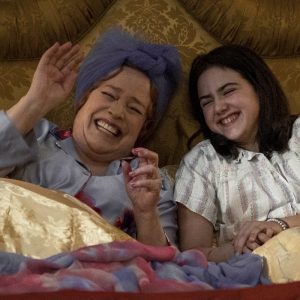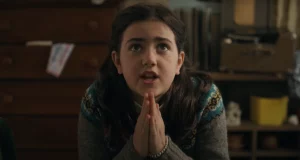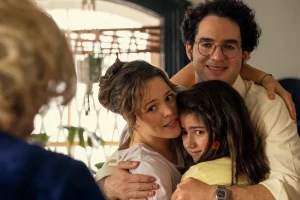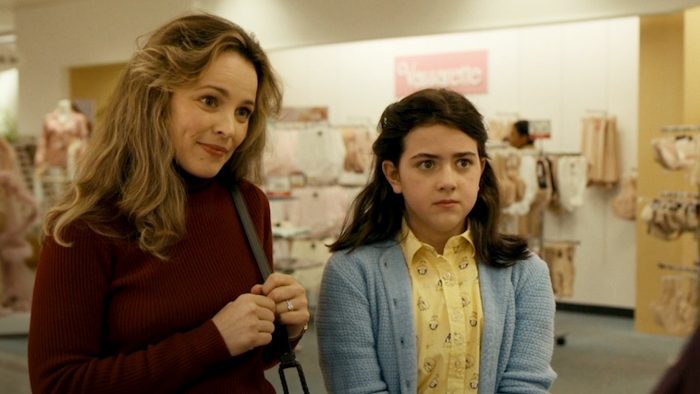Reviewed by Jeffrey Sanzel
No writer has been more heralded nor adored than Judy Blume. Author of over two dozen novels, she debuted with the children’s book The One in the Middle Is the Green Kangaroo (1969) and followed up with Iggie’s House (1970). But her third book—Are You There, God? It’s Me, Margaret—truly launched her career. Others include a combination of works for children (Tales of Fourth Grade Nothing, Otherwise Know as Sheila the Great, Blubber), young adults (Then Again, Maybe I Won’t, Deenie, Forever …), and adults (Wifey, Summer Sisters, It’s an Unlikely Event).

Only a handful of Blume’s works have made it to the screen: Forever, Otherwise Known as Sheila the Great, Tiger Eyes, and a television series based on Fudge-a-Mania. Now Kelly Freemon Craig, who wrote and directed the 2016 coming-of-age dramedy The Edge of Seventeen, helms the big screen version of Are You There, God? It’s Me, Margaret. Craig has fashioned an agreeable, appropriately gentle, and predominantly loyal adaptation.
The film opens with a montage of twelve-year-old Margaret Simon’s (Abby Ryder Fortson) last days at a New Hampshire girls’ camp. Upon her return to New York City, her parents, Barbara and Herb (Rachel McAdams and Benny Safdie), inform her that her father’s work promotion has enabled the family’s move to New Jersey. Unsurprisingly, Margaret and her paternal grandmother, Sylvia (Kathy Bates), are unhappy with the turn of events.
Quickly, though, Margaret settles into a suburban world of backyards and sprinklers. She is not so much greeted but assaulted by neighbor and fellow sixth-grader Nancy Wheeler (Elle Graham). Nancy, an alpha and mean-girl-in-training, gathers Margaret into her close and closed-friend group, Janie (Amari Alexis Price) and Gretchen (Katherine Kupferer).
Margaret’s realm revolves around school, boys, and family. It is an analog world without the technical hurdles of later generations (with not even a television in sight). Often, the atmosphere has a sixties vibe—most notably Nancy’s Stepford mother (Kate MacCluggage), who seems a refugee from the 1950s.

In the book, Margaret’s dilemmas were split equally between her religious identity crisis and her body’s burgeoning changes. When Barbara and Herb married, Barbara’s parents were so distraught over her having a Jewish husband they cut off all connection. Barbara and Herb decided to raise Margaret with no religion, telling their daughter to decide when she was old enough. Much of Margaret’s quest in the book is sampling Jewish and Christian experiences.
The struggle remains present in the film, but Craig emphasizes Margaret’s focus on her impending physical transitions. The girls’ discussions are neatly taken from the book, creating believable interactions. In fact, much of the dialogue—including the quartet’s memorable chant—is smartly lifted verbatim.
The film and its tone occasionally nod towards twenty-first-century political correctness, but nothing hampers the storytelling. The biggest departure is Barbara leaving her job now that they have left the City. In the book, she is a housewife who paints less-than-successful pictures of fruit. Here, she is an edgier artist and art teacher searching for a place in this new life. At first, she tries to integrate into the new community but must ultimately find herself again. In doing this, Rachel McAdams’ Barbara is a more dimensional, if modern, character than her literary counterpart.

Abby Ryder Forston easily holds center in an honest and realistic portrayal of a preadolescent. Whether she is mooning over the boy who cuts the grass or asking God for guidance, she remains grounded and unshowy. McAdams, always strong, makes the most of the two sides of Barbara and connects with the character’s trials. Safdie is kind and present as the father, while Bates humorously blends West Side polish with Jewish guilt. Special mention of Graham, whose toxic delivery of the line, “I live in the bigger house up the street,” speaks volumes to Nancy’s self-assurance. Echo Kellum leans towards charming rather than bumbling as the first-year teacher, Mr. Benedict.
One surprising film deviation is Margaret’s lack of awareness regarding the schism between her mother and grandparents. The choice ratchets up the immediacy of the conflict with their visit late in the story. (The scene clumsily includes Sylvia and her beau, absent from the book’s confrontation.) While dramatic, it undermines Barbara and Herb’s honesty with their child. In addition, the bullying of the more physically mature outsider Laura Danker (subtle and pained as played by Isol Young) ends in a kinder, if less realistic, resolution.
Had Are You There, God? It’s Me, Margaret been made fifty years ago—or even forty or thirty—its impact would have possessed more resonance. The film’s quaintness dulls some of the novel’s powerful edges, leaning toward nostalgia rather than reflection. However, one suspects viewing the film will be an experience for mothers and daughters (and granddaughters) to connect with a coming-of-age that has spanned multiple generations. Those looking to revisit a favorite tale told with integrity will welcome this faithful adaptation.
Rated PG-13, the film is now playing in local theaters.





